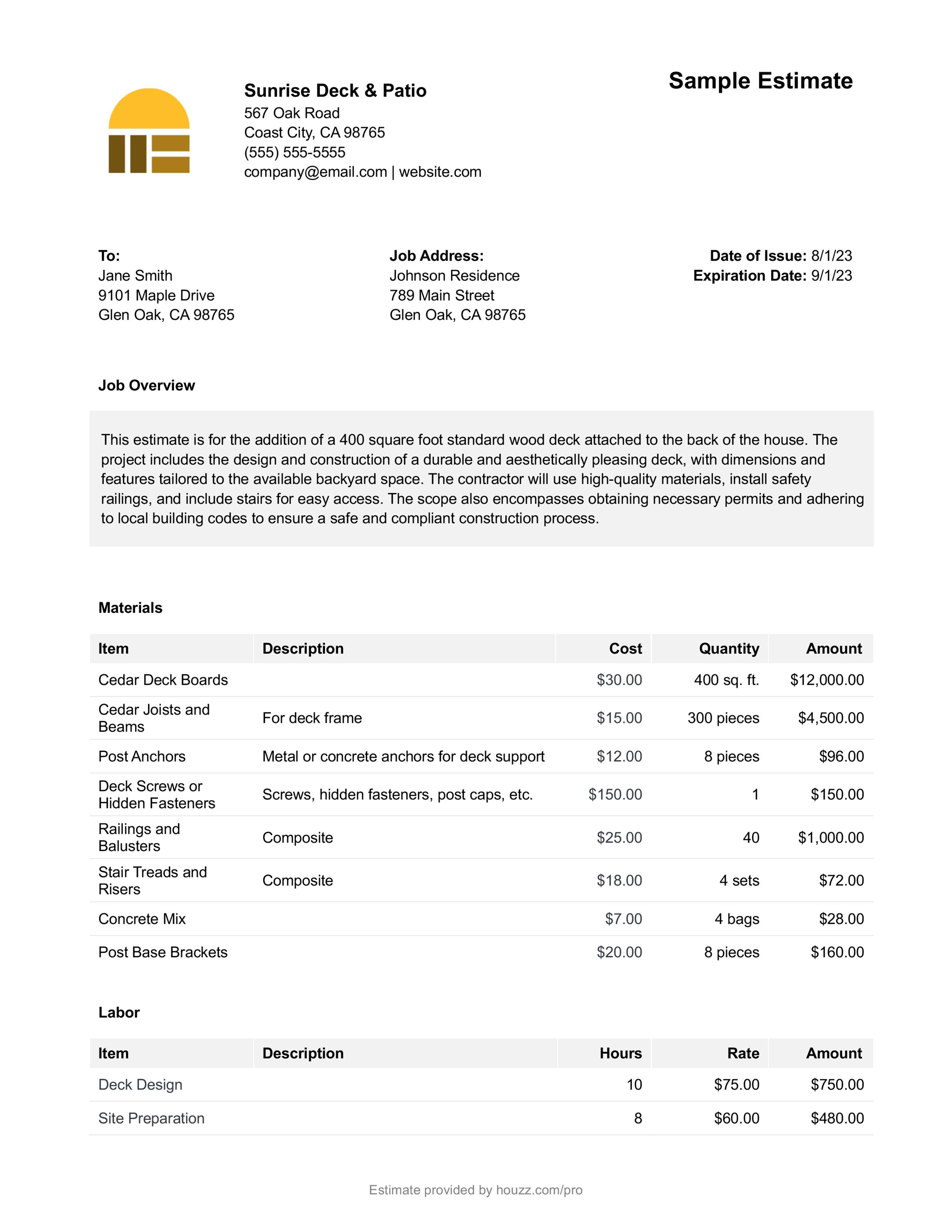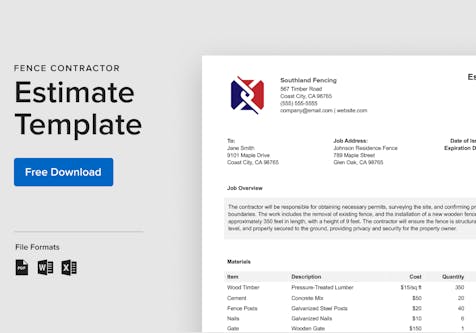Free Template: How to Estimate a Deck Job
How to Estimate a Deck or Patio Job Like a Pro: Step-by-Step Guide

Are you looking for a comprehensive guide on how to estimate a deck job? Estimating a deck or patio job can be a daunting task, but with the right steps and tips, you can get an accurate deck job estimate example. In this blog, we discuss the basics of how to estimate a deck job and provide a step-by-step guide to help you get started. From gathering the necessary materials to determining labor costs, we’ll cover all the key factors to help you estimate a deck job like a pro.
We also include a free, downloadable deck job estimate template to get you started.
Click on a link below to jump to the section you’re most interested in:
- Download our free deck estimate template
- What is a deck estimate?
- Why are deck estimates important?
- When do you send a deck estimate?
- What should be included in a deck estimating spreadsheet?
- Optional sections to include in a deck estimate template
- How to create a deck estimate step-by-step
- Alternatives to deck estimate templates
- Final tips on how to estimate a deck job
Download our Free Patio or Deck Estimate Template

Here's a Patio & Deck Estimate Template on Us!
Customize this Deck Estimate Template to secure your next job.
As a new deck contractor, pricing your services accurately is crucial for the success and growth of your business. Using a deck estimate template is a great way to learn how to create a professional and competitive estimate for a deck or patio project because it guides you through everything that construction pros include in their estimates. Plus, the template is fully editable so you can customize it to meet your specific needs. You can also view the deck estimate sample to see an example of a completed estimate for inspiration.

Over the long run, experienced construction pros often turn to business management software such as Houzz Pro to create estimates as quickly and professionally as clients expect. All-in-one management software designed specifically for contractors helps them run their businesses more efficiently. Explore our other templates for deck and patio contractors with a free trial of Houzz Pro.

What is a patio or deck estimate?
A patio or deck estimate spells out all the necessary materials, labor, and equipment needed to complete the project. It helps you provide your client with the likely cost and build a strong foundation for a successful working relationship. An estimate has more wiggle room than a quote, bid or proposal and it is not legally binding.
Estimates help clients understand whether the project fits their budget and expectations. If accepted, it is typically followed up with a specific quote which becomes the basis of the project budget once it is signed by all parties. For some jobs, a more detailed bid or and even more detailed proposals may be requested.

Why are deck estimates important?
Understanding the scope of a deck job is essential when it comes to estimating the project accurately and assuring that the pricing will cover your expenses and assure you earn a profit to keep your business growing. As a deck or patio contractor, it is crucial to have a clear understanding of what your client wants and needs in order to provide an accurate estimate. This involves conducting a thorough assessment of the project site, taking measurements, and understanding any specific requirements or challenges that may arise during the construction process.
Here are some factors that can influence a deck estimate:
- New Construction or Replacement In some ways, building a new deck is more straightforward than replacing one because no demolition is required, and the plan and design is often clearer. Don’t forget to consider the cost of demolishing, hauling and dumping any existing structures.
- Materials Whether it's wood, vinyl or composite, the cost of the decking materials is one of the biggest variables in estimating the project. The type of materials preferred by the client can vary the price significantly.
- Railing system The railing choice for decks also makes a big difference in the final estimate for the project. Wood, cable, and composite are among some of the more popular choices, but their pricing varies.
- Complexity of Structure Consider the complexity of the deck job and the amount of time and effort it will require. More intricate designs or challenging site conditions may warrant a higher price. On the other hand, if the project is straightforward and requires less time and effort, you may be able to offer a lower price to attract clients.
- Terrain The condition of the existing land can add to the project challenges in preparing the site. Plus, consider if there will be any extra difficulties - and therefore costs - in bringing in equipment and materials.
- Square footage Naturally, the size of the project impacts the price. Therefore, taking accurate measurements of the project square footage to determine the materials needed is a starting point for any deck or patio project.

When do you send a deck estimate?
Estimates are typically the first document deck and patio construction pros send to a client to help them understand what their dream project will cost. The impression it makes is important in helping homeowners make their decision on which contractor to choose for the work. Aim for an estimate that makes it easy for clients to understand the costs behind the work, and is professional in appearance.
Once a client accepts an estimate and has all their questions answered, follow up with a formal quote for them to sign.

What should be included in a patio or deck estimating spreadsheet?
Most deck or patio estimate templates include the same basic information. Here is a list of the essential elements to cover in your patio or deck estimate:
- Your Company Details Include your business logo and name to make the estimate uniquely yours and give it professional polish. Make it easy for clients to know how to contact you or the person designated for their project.
- Client Information Add the the name of the client and the contact information of the person who will be the main point of contact for the project.
- Estimate Number Devise an intuitive numbering system for your estimates so that they will be easily located and tracked.
- Date Adding a date is crucial for tracking and locating documents. Also, it is wise to note how long the prices included in the estimate are in effect so you can adjust for market and supply changes as needed.
- Summary of Costs Note all the costs associated with the project and arrange them in an easy-to-read format so that everyone is on the same page.
- Acceptance & Signature End with a line for all parties to sign and date.

Optional Sections to Include in a Patio or Deck Estimate Template
Besides the basic information, some construction professionals include additional details in their estimate, depending on their needs and circumstances. Here are some other topics to consider adding when drafting a deck estimating spreadsheet:
- Payment Schedule What percentage of the project cost will you require up front before the project begins? Note when payments will be due throughout the life of the deck project. This is usually the same for every project depending on the policy you have set for your business.
- Suppliers In some cases, you may want to note some of the pertinent suppliers of the materials you will be purchasing for the project.
- Project Schedule Adding the approximate start and finish date can help clients determine whether this fits with their expectations and schedule and provides clarity.
- Scope of Work It is crucial to have a clear understanding of what the client wants and needs in order to provide an accurate estimate. Summarizing the scope of work can illustrate to clients that you understand their expectations. It can also help avoid misunderstandings down the line.
- Discounts List any incentives you offer such as reduced rates for payments up front, or discounts for new customers.
- Terms & Conditions Include policies you have set around the terms and conditions of the work such as change orders or how long a client has to inspect the final project for quality and completion.
- Additional Notes Consider if this project requires any other clarifications or notes you want to add.

How to Create a Patio or Deck Estimate Step-by-Step
Ok, now let’s get started. Here’s a step-by-step guide for creating a deck or patio estimate:
1. Choose an Estimate Tool Thankfully, you do not need to start with a blank screen. Choose the tool you are going to use to draft the estimate. If using a template or deck estimating spreadsheet, make sure it is downloadable so you can easily print it and email it. Also, it should be fully editable so you can customize it for your business. Using a management software designed for deck and patio contractors will make the job even more effortless.
2. Review Project Plan & Scope Before beginning the estimate, it is important to meet with the client and discuss their vision for the deck or patio. This conversation should cover details such as the deck's size, shape, materials, and any additional features they may want, such as stairs, railings, or built-in seating. By having a clear understanding of the client's expectations, you can accurately estimate the cost and time required to complete the project. You may want to visit the site to assure you have a clear idea of the entire scope.
3. Do Takeoffs
- Determine Square Footage Measure the height, width and depth of the deck to get your total square footage. Take into account the existing terrain while measuring to assure your totals are accurate.
- Determine Material Length & Spacing Figure in the length of the lumber or material that will make up the deck. Determine the spacing between each length.
- Account for Waste & Cutoffs Remember to figure in the waste that will depend on the type of project you are doing. This includes measuring both the length and width of the deck, as well as any areas where the deck will need to be cut or shaped. And, also account for the mistakes that sometimes happen in cutting the materials.
4. Estimate Materials
When it comes to estimating a deck job, calculating material costs is a crucial step. The materials you choose will have a significant impact on the overall cost of the project. Determine the type of materials you will be using. This could include options such as pressure-treated lumber, composite decking, or hardwood. Each material will have its own cost, so be sure to research and compare prices to find the best fit for your project and budget.
Here are some other factors to consider when estimating materials:
- Fasteners, joists, beams and posts These items are essential for the stability and durability of the deck and should be factored into your material cost estimate.
- Features or Accessories This could include things like lighting, or built-in seating.
- Railings Consider the type of materials and cost whether it is wood, cable, wrought iron or composite material.
- Piers, Footings Determine the cost of the materials and associated expenses.
- Hardware Are there other decorative items included such as copper post caps or gates?
- Fuel The location of the work especially if the site is in a rural area will add to your fuel and transportation costs.
- Equipment Decide what equipment is needed and if there are additional challenges to access the site to pour the concrete for the footings, for example. Add in those costs.
- Permits, Fees Don’t forget the cost of building permits and other fees such as disposal of demolition materials.
5. Estimate Labor Costs
One of the key aspects of estimating a deck or patio job is accurately determining the labor costs. This step is crucial in ensuring that your estimate is comprehensive and reflective of the true expenses involved in the project.
- Include all labor costs When it comes to estimating labor costs, you need to consider several factors. Start by breaking down the various tasks required for the deck construction, such as excavation, framing, decking installation, and finishing touches.
- Time Costs Estimate the amount of time each task will take and determine how many workers you will need to complete them efficiently.
- Specialty Labor Don't forget to include any subcontractors or specialized tradespeople that may be necessary for specific aspects of the project.
- Labor Rates Consider the wages or hourly rates for the workers involved. Research the average rates in your area and take into account any additional costs such as benefits or insurance. This will give you a more accurate estimate of the labor expenses involved.
6. Determine Markup & Factor in Overhead
- Your Costs Pricing your services accurately is crucial for the success and growth of your business. A key step to doing this is assessing your own costs and overhead expenses. This includes your labor costs, equipment costs, insurance, licensing fees, and any other administrative expenses. By understanding your own expenses, you can set a competitive and profitable price for your services.
- Profit Margin Research the market and analyze the pricing strategies of your competitors. It's important to know what other contractors are charging for similar deck jobs in your area. This will give you a better idea of the industry standards and help you set a price that is competitive but also allows you to make the percentage profit you are seeking.
7. Calculate Total Costs Add up all the costs to get your total.
8. Seek a Second Opinion Ask someone you trust to review your estimate to help assure you have not missed any crucial elements.
9. Review & Send Give your deck or patio estimate one last look and hit send!
10. Track Feedback The work does not end here. Devise an easy way to track feedback from your clients and record approvals.

Alternatives to Patio or Deck Estimate Templates
As a new or experienced patio or deck contractor, finding ways to streamline your deck job estimation process can save you time, effort, and headaches. Luckily, there are tools available that can help simplify and automate the process, allowing you to focus on growing your business and providing top-notch service to your clients.
Deck estimate templates are a great tool to start honing your estimating skills, but many contractors find they can run their businesses more efficiently by using and estimating software. Houzz Pro Deck Builder Estimating software includes pricing databases for your region or you can upload your own.
With takeoffs built in, deck contractors deliver estimates twice as fast with Houzz Pro estimating software. Learn how deck builder estimating software can get you away from your desk faster and help you deliver estimates to clients faster than your competitors.

Final Tips on How to Estimate a Deck Job
- Define the Scope: Take the time to thoroughly understand the scope of the project. Rushing through this step can lead to overlooked details or miscommunication with the client. Be sure to ask questions, clarify expectations, and carefully assess the project site before providing an estimate.
- Evaluate Skills Required Your cost of labor will vary depending on the intricacy of the project and the skill level needed to carry out the project. Also, consider the availability of the labor pool in your region.
- Account for Project Risks & Challenges During the assessment of the project site, consider any potential challenges or limitations that may affect the construction process. This could include factors such as the terrain, existing structures, accessibility, and any local building codes or regulations that need to be followed.
- Remember Overhead Costs Running a business costs money and accurately valuing those expenses helps assure you will earn a profit and grow your company for years to come.
- Compare to Competitors Understand your place in the market to help you decide whether your pricing is competitive. Adjust as needed to find the right balance.
- Learn from the Past What lessons have you learned through past projects and how can you apply them going forward?

Conclusion
Building strong client relationships is essential for the success and growth of your business. One of the most effective ways to do this is through transparent and accurate estimation. When you provide your clients with a detailed and honest estimate, and in a timely manner, it demonstrates professionalism, integrity, and a commitment to delivering high-quality work.
Following the tips in this guide can help you learn how to make deck and patio estimates with confidence and ease.
Consider investing in project management and estimation tools that can help you track and organize your projects from start to finish. These tools come with features such as scheduling, budgeting, and collaboration tools that can streamline your workflow and keep you organized.
Explore Houzz Pro takeoff, estimating features and 3D modeling tools with our deck builder business software. To continue learning, check out our next guide on How to Create a Construction Invoice.

Want advice delivered to your inbox?
Unlock industry insights and updates for contractors and design pros
By signing up, I agree to the Houzz Terms of Use and Privacy Policy and that Houzz may use my information to contact me about relevant content, products, and services.






Join the conversation by commenting or asking a question below. The Houzz team reads every single comment, and we’ll get back to you by email if you need us!